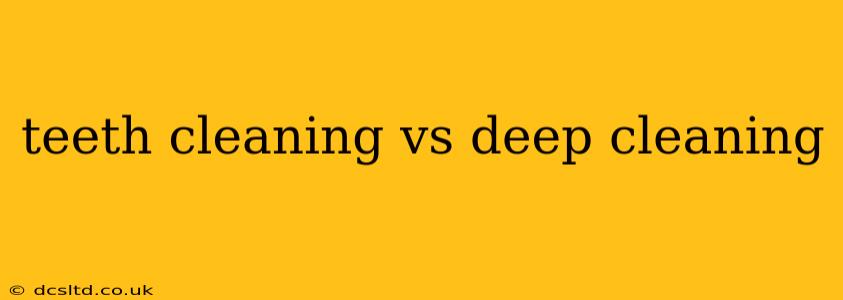Maintaining optimal oral health requires understanding the difference between regular teeth cleaning and a deep cleaning. While both are crucial for preventing gum disease and other dental problems, they differ significantly in their approach and necessity. This comprehensive guide clarifies the distinctions, helping you make informed decisions about your oral care.
What is a Regular Teeth Cleaning?
A regular teeth cleaning, also known as a prophylaxis, is a preventative procedure performed by a dental hygienist or dentist. This typically involves:
- Removal of Plaque and Tartar: Plaque, a sticky film of bacteria, constantly forms on your teeth. If not removed daily through brushing and flossing, it hardens into tartar (calculus), which only a professional can remove. Tartar is a major contributor to gum disease.
- Polishing: After removing plaque and tartar, the teeth are polished to remove surface stains, leaving them feeling smooth and clean.
- Fluoride Treatment (Often): A fluoride application strengthens tooth enamel and helps prevent cavities.
- Oral Cancer Screening: The hygienist will also visually check for any signs of oral cancer.
Regular cleanings are recommended every six months, though your dentist might recommend more frequent visits based on your individual needs and risk factors. This preventative care is key to maintaining healthy gums and teeth.
What is a Deep Cleaning (Scaling and Root Planing)?
A deep cleaning, also known as scaling and root planing, is a more extensive procedure necessary for individuals with periodontal disease (gum disease). This involves:
- Removal of Deeply Embedded Tartar: Unlike regular cleanings that focus on the surface, deep cleaning targets tartar and bacterial buildup below the gum line.
- Root Planing: This process smooths the tooth roots to remove bacteria and toxins that contribute to gum inflammation.
- More Thorough Examination: A deep cleaning involves a more in-depth examination of your gums and teeth to assess the extent of periodontal disease.
Deep cleanings are typically performed over two separate appointments, focusing on different sections of the mouth each time. This allows for proper healing and minimizes discomfort.
How Often Should I Get a Deep Cleaning?
The frequency of deep cleanings depends entirely on the severity of your gum disease and your response to treatment. Some individuals might need a deep cleaning only once, while others require them more regularly, potentially every three to six months. Your dentist will determine the appropriate schedule based on your condition.
What are the Signs I Need a Deep Cleaning?
Several warning signs might indicate the need for a deep cleaning:
- Bleeding Gums: Bleeding while brushing or flossing is a significant indicator of gum inflammation.
- Swollen or Red Gums: Inflamed gums often appear red and swollen.
- Receding Gums: Gums pulling away from the teeth exposes more of the tooth root, making it vulnerable to decay and infection.
- Persistent Bad Breath: Bad breath (halitosis) can be a sign of underlying gum disease.
- Loose Teeth: Advanced gum disease can weaken the ligaments holding your teeth in place, leading to tooth mobility.
- Pus Between Teeth and Gums: The presence of pus is a clear sign of infection.
If you experience any of these symptoms, schedule an appointment with your dentist immediately. Early detection and treatment are crucial for managing gum disease.
Is a Deep Cleaning Painful?
While a deep cleaning is more involved than a regular cleaning, most patients report only mild discomfort. Your dentist can administer local anesthesia to numb the area, minimizing any pain during the procedure. Some patients may experience some sensitivity and soreness after the cleaning, but this typically subsides within a few days.
What is the Cost Difference Between Teeth Cleaning and Deep Cleaning?
The cost of a regular cleaning is typically covered by dental insurance, while deep cleanings often have a higher out-of-pocket expense, depending on your insurance plan and the extent of the procedure. It's always recommended to check with your insurance provider beforehand to understand the coverage for both regular and deep cleanings.
What are the Long-Term Benefits of Regular and Deep Cleanings?
Both regular and deep cleanings are critical for maintaining long-term oral health. Regular cleanings prevent the buildup of plaque and tartar, minimizing the risk of cavities and gum disease. Deep cleanings effectively treat gum disease, preventing further damage and preserving your teeth and gums. Regular visits, coupled with diligent home care, are the cornerstones of a healthy smile.
This detailed explanation provides a clear understanding of the differences between regular teeth cleaning and deep cleaning. Remember to schedule regular checkups with your dentist to maintain optimal oral health and address any potential problems early.
